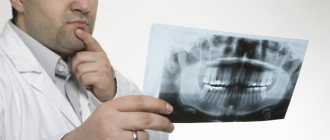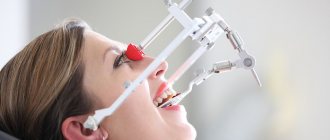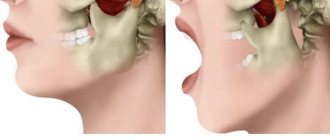Structure
The formation of the mandibular region is the result of the evolution of the human body. In the process of development, the entire structure became mobile and autonomous, gaining the ability to move freely and perform the basic functions necessary for a person. The temporal joint is localized in the fossa, connecting to the bony part.
When a subluxation occurs, the head of the joint partially comes out of the fossa, succumbing to the influence of external factors. As a rule, this phenomenon becomes a consequence of a general weakening of the ligaments or disturbances in the articular cavity. If you have the proper skills and practical experience, you can restore the original position of the jaw yourself, but the systematic occurrence of such a problem is the basis for complex treatment.
Symptoms
A slightly open oral cavity, non-closure of lips and teeth, slurred speech are typical signs of joint damage on both sides. Patients are worried about symptoms such as pain in the ear area, and the symmetry of the face may be disturbed, as the chin moves forward. Additionally, the symptoms of this type of jaw dislocation are:
- A doctor's examination shows that the masticatory muscle fibers in such patients are tense.
- They usually have thickened cheeks;
- The displacement is determined by palpation;
- When trying to close the mouth using pressure, springy movements and painful sensations appear;
The clinical picture of unilateral displacement is almost the same. The difference is that the chin is directed from the middle to the healthy side, which causes a distortion of the lower part of the face. Clicking and crunching sounds may be heard. If the head is displaced back, the patient will not be able to open his mouth. His speech and breathing are difficult. If the pathology is complicated, swelling is clearly visible, and hematomas may be present.
Causes and classification
Displacement of the lower jaw is the result of the application of an external force that exceeds in intensity the force of natural fixation. For each person, such a threshold is individual - some patients may suffer from minor force, while others are able to endure strong mechanical impact without consequences.
The main factors determining the tightness of the fit are ligament tension and bone attraction. The weakening of these connections can provoke the occurrence of subluxation, both one-time and in a chronic form. The reasons that negatively affect the condition of the jaw region include:
- Advanced stages of rheumatism;
- Developing arthritis or osteomyelitis;
- The occurrence of cramps and muscle spasms;
- Consequences of encephalitis;
- Epileptic seizures.
They also note the existence of traumatic factors, the occurrence of which can cause subluxation:
- Mechanical injuries - impacts, collisions;
- Excessive opening of the mouth;
- Having bad habits;
- Congenital abnormalities that affect the formation of the articular fossa.
The classification used in dentistry differentiates pathology according to the following criteria:
- Based on the position of the articular head - anterior, posterior and lateral subluxation;
- According to the specificity of the displacement - one-sided and two-sided form;
- Depending on the severity - for simple and complex cases.
The choice of technique, as well as the timing of treatment, depend on the original source of the problem. It is easiest to cure the pathology in the early stages, so at the first symptoms of subluxation it is recommended to consult a doctor and undergo an examination.
Causes of dislocation
Often, displacement can occur from a sudden movement of the jaw bone itself, as well as from rough external influences. It happens that pathology develops when yawning, opening the mouth too wide, laughing, singing, screaming. In addition, dislocation of the lower jaw occurs:
- As a result of pulling out teeth, taking impressions of them;
- When performing tracheal intubation and bronchoscopy;
- When cracking nuts;
- When a patient receives a strong blow to the jaw;
- If an injury or fracture occurs from a fall on the chin;
- When the patient has an incorrect bite;
Patients with rheumatism, gout, arthritis, and epilepsy are predisposed to such anomalies. It happens that pathologies appear because the surfaces and elements of the joint unit gradually shift. The disease can be congenital. Anomalies are divided into posterior, anterior, 2-sided, unilateral, chronic, and habitual.
Symptoms and signs
For each form of subluxation, there are characteristic individual signs that indicate the presence of deviations. However, there are a number of universal symptoms observed in all types of pathology:
- The occurrence of pain of varying severity, aggravated when the patient attempts to move the lower jaw;
- Limited mobility of the temporomandibular joint, making it difficult to perform usual actions - eating or speaking;
- Active secretion of saliva associated with a swallowing problem.
In addition, with bilateral dislocations affecting the anterior zone, the following circumstances occur:
- Inability to close the jaws, forcing the patient to keep his mouth open;
- Pain in the skull and swelling of tissue in the ear area;
- Partial or complete dysfunction of the speech apparatus.
The unilateral form of subluxation has similar symptoms, but allows partial closure of the mouth, which significantly alleviates the patient’s problems. In turn, posterior bilateral subluxation is characterized by the opposite symptomatology - the inability to open the jaw, pressing of the lower part into the larynx area.
First aid and treatment
If a subluxation occurs, it is recommended to straighten the jaw using the infiltrative or guide method, after first calming the patient and giving him an anesthetic. The lack of such skills requires contacting a qualified orthodontist, who will not only restore the natural structure of the jaw apparatus, but also advise measures aimed at restoring and preventing recurrences. If the procedure aimed at realigning the joint is carried out in a timely manner, as well as medical recommendations are followed during the rehabilitation period, the prognosis for a complete cure is very favorable.
Dislocation of the lower jaw
First aid consists of reversing the dislocation of the lower jaw under infiltration or conduction anesthesia. To reduce the anterior dislocation of the lower jaw, the methods of Hippocrates, Khodorovich, Blechman, Gershuni, Popescu (for old dislocations) are used. The classic way to reduce bilateral dislocation of the lower jaw is the Hippocratic method: the patient sits on a low chair, so that the back of the head is supported, and the lower jaw is located at the level of the elbow joints of the dentist or traumatologist/surgeon. Standing opposite the patient's face, the doctor places his thumbs, wrapped in a towel or a thick layer of gauze, on the lower molars, and with the rest covers the lower jaw from the outside. Gently pressing down with his thumbs, the doctor moves the jaw back with a small push, quickly removing his fingers from the teeth to avoid biting. The movement of the articular heads of the lower jaw into place is accompanied by a characteristic click and intense closure of the jaws.
When reducing a posterior dislocation after the lower jaw has been displaced downward, it is moved anteriorly. In order to avoid recurrent dislocation of the lower jaw and limit movement in the TMJ after the reduction procedure, it is necessary to immobilize the jaw using a chin sling for 7-10 days (for anterior dislocation) and for 2-3 weeks (for posterior dislocation). Until recovery, the patient is advised to stop eating solid food and follow a gentle diet. If it is impossible to reduce the dislocation of the lower jaw using conservative methods, they resort to the surgical method. For chronic dislocations of the lower jaw, resection of the articular heads of the lower jaw may be required, followed by mechanotherapy.
Patients often learn to adjust habitual dislocations of the lower jaw on their own. Further treatment should include therapy for the underlying disease, wearing it for 2-3 months. medical orthopedic devices and splints that limit mobility in the joint (Petrosov apparatus, Burgonskaya-Khodorovich apparatus, Yadrova splint). According to indications, it is necessary to carry out selective grinding of teeth, prosthetics of missing teeth, blockade of masticatory muscles, massage, therapeutic exercises, physiotherapy (electrophoresis of medicinal substances, galvanization).
Surgical treatment of habitual dislocation of the lower jaw can be aimed at strengthening the ligaments, deepening the articular cavity, increasing the height of the articular tubercle, repositioning and fixing the intra-articular disc.
Symptoms of TMJ dislocation
The most characteristic sign of TMJ dislocation is limited mobility of the lower jaw, up to the inability to close the mouth. In addition, the pathology is usually accompanied by tension in the facial muscles.
In the bilateral anterior form, the lower jaw is displaced downward, the patient cannot close it independently, and movements are impossible. This condition is accompanied by constant pain, excessive salivation, and slurred speech. The doctor can palpate the temporal area under the tragus of the patient's ears and detect depression on both sides.
For unilateral anterior dislocation, a characteristic symptom is pronounced facial asymmetry. The lower jaw is displaced downward and to the side, in the direction of the healthy joint. The mouth is half-open, speech is slurred, and excessive salivation is also observed. Such dislocations, as a rule, occur due to a lateral impact in the lower jaw area.
To clarify the diagnosis, the dental surgeon may refer the patient for an X-ray or computed tomography scan of the joints. This allows you to clarify the shape of the dislocation, as well as exclude possible fractures or bone cracks that could have occurred as a result of the injury.
Causes
The reasons for displacement of the jaw bones from their original position can be divided into 2 categories: traumatic and non-traumatic. The first category of factors provoking the problem include: bruises, accidents, falls, blows.
Non-traumatic causes include:
- chewing rough foods;
- wide opening of the jaw by a person during yawning;
- diseases of the ligamentous apparatus (rheumatoid arthritis, osteoarthritis, osteomyelitis).
If medical care is not provided in a timely manner, swelling and hematoma gradually appear in the area of the dislocation. Lack of adjustment also leads to the transition of the dislocation to the old stage. The disorder is characterized by weakening of the jaw muscles, the formation of compacted scars at the site of injury, and the inability to hold the jaws in an anatomically correct position even after reduction. A person's chewing and speech functions are impaired.
Group No. 1: complete and incomplete
Only the lower jaw can be dislocated, since it is the one that is mobile. Under the influence of negative factors (too wide opening of the mouth, weakening of ligaments, injuries, chronic diseases), its articular head can jump out of the recess in which it is located. However, jaw dislocation can vary depending on how severe the displacement was. If the articular head is completely torn off and greatly displaced from its place, as shown in the photo, then this is a complete dislocation of the jaw.
The photo shows a complete dislocation of the jaw
There is also incomplete dislocation, when the head is only partially displaced and at the same time continues to come into contact with the articular surfaces. In this case, we are no longer talking about a dislocation, but about a subluxation of the jaw.
Why is this important to understand? With a complete dislocation, when the jaw pops out, you will not be able to cope with the problem on your own. It is necessary to have a specialist handle the reduction of the articular head. In the second case, that is, with subluxation, it often happens that after a short period of time the joint returns to its original position on its own, and the patient does not require emergency medical care. There are different types according to their symptoms:
- complete dislocation: acute pain, facial asymmetry, mouth open and impossible to close. It will be impossible to eat or speak in this state, it will be difficult to swallow,
- subluxation of the jaw: here the symptoms will be much less vivid and alarming. Possible crunching and clicking in the jaw, discomfort.










